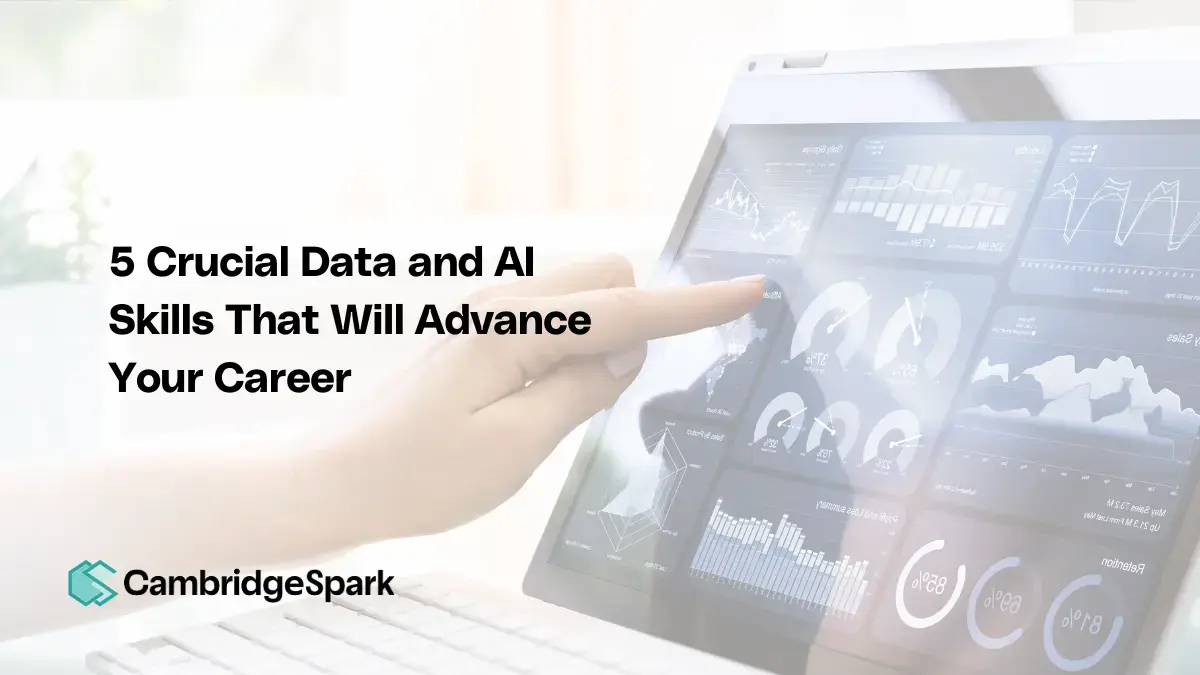A recent survey conducted by Access Partnership and Amazon Web Services (AWS) found that 73% of employers prioritise hiring AI-skilled talent.
This blog explores the top five data skills that are transforming the workplace. Continue reading to discover how mastering these skills can elevate your career and put you ahead in your field.
1. Machine learning
In the World Economic Forum's 2023 Future of Jobs Report, AI and machine learning specialists top the list for projected job creation from 2023 to 2027. As technology evolves, and our reliance on it to perform our job roles continues to increase, this trend comes as no surprise.
But what is machine learning, and why are so many organisations eager to invest more in this field in the near future?

Machine learning is a branch of artificial intelligence. It focuses on building systems or models that learn from and make decisions based on data, using algorithms to perform specific tasks.
The process involves continually feeding data into these models, which are then adjusted and refined to enhance accuracy over time.
Machine learning is pivotal in making computers more intelligent, allowing them to identify crucial insights without human intervention.
Here are several job roles that predominantly use machine learning:
- Machine learning engineer
- Data scientist
- AI research scientist
- NLP (natural language processing) Engineer
Upskilling in machine learning can help you position yourself as a leader in the digital economy. And harnessing these skills gives you the capability of adapting to technological advances and market changes more effectively.
Some general use cases of machine learning that would benefit an organisation could be:
- Customer segmentation: Machine learning algorithms can analyse customer data to segment those customers based on behaviour, preferences, and demographics.
This enables businesses to tailor marketing strategies and personalise services, improving customer engagement and retention. Moreover, 76% of consumers say that they are more likely to purchase from a brand that personalises their customer experience. - Sales forecasting: By examining historical sales data, machine learning models predict future sales trends. This helps businesses with inventory management, planning promotions, and allocating resources more effectively.
- Dynamic pricing: Machine learning models can also adjust prices in real-time based on market demand, competitor pricing, and other external factors. This is especially useful for airlines, hospitality, and e-commerce sectors to maximise revenue.
For a less commercial example, let's consider the case of David Howell, Joint Director for Strategic Insight and Analytics at Surrey Heartlands Health and Care Partnership.
David applied his expertise in data and AI to develop a machine learning model that reliably predicts 70-80% of emergency readmissions that could have otherwise been avoided.
Accurately forecasting emergency readmissions can significantly enhance the efficiency and capacity of NHS healthcare services, potentially saving lives by ensuring timely and adequate care.
David said:
 "There’s clearly a lack of implementation of machine learning within healthcare. I think people don’t necessarily see how these insights and analytics teams could be used to really start to help patients and citizens more proactively. And I was really keen to lead by example and actually take people on that journey."
"There’s clearly a lack of implementation of machine learning within healthcare. I think people don’t necessarily see how these insights and analytics teams could be used to really start to help patients and citizens more proactively. And I was really keen to lead by example and actually take people on that journey."
2. Generative AI
It's the topic on everyone's lips, but how much do you really know about generative AI (GenAI)? Learning how to use GenAI to optimise your work output can be a game changer and put you ahead in today’s business world.
No matter what industry you work in or what role you have, we can bet that GenAI can support you with your daily workload.
So, what exactly is it? GenAI refers to artificial intelligence that creates new content, ranging from text and graphics to videos and even code. These models learn from data to mimic and generate output that resembles human-created content.
For instance, ChatGPT is a popular example of GenAI software that was launched in 2022. It’s just one of many tools working professionals are using to automate or augment various tasks.
A recent survey revealed that more than 93% of employers and 86% of employees anticipate using GenAI within the next five years. They expect it to enhance innovation and creativity, automate repetitive tasks, and boost learning within their organisations.
Let's explore some of the ways GenAI can assist you and your organisation in more detail:
- Content creation: GenAI can help speed up many aspects of content production for those in creative fields, whether creating marketing collateral, written articles, or even programming code.
- Automated customer support: GenAI revolutionises customer service by offering instant, round-the-clock responses to enquiries through chatbots. This technology not only reduces wait times but also allows human agents to focus on more complex issues, enhancing overall service efficiency.
- Product design: Companies can use GenAI to innovate product designs by simulating countless variations, enabling them to explore creative solutions and refine product features quickly.

3. Python for data analytics
According to the 2023 Stack Overflow Developer Survey, Python remains one of the most popular programming languages among developers. It is particularly favoured by those in data science and machine learning fields and is widely used for data analysis, web development, and artificial intelligence projects.
When it comes to data analysis, Python is a top choice for many analysts. Libraries like Pandas make it easy to organise and manipulate data, while NumPy handles large numerical datasets.

Some of the key benefits of using Python for data analysis are:
- Ease of learning and use: Python's syntax is clear and intuitive, making it accessible to beginners. This ease of use allows data professionals to quickly write and execute data analysis scripts efficiently.
- Versatility: Python is extremely versatile, which allows analysts to handle data processing, statistical analysis, machine learning, and data visualisation all within a single environment.
- Good integration capabilities: Python integrates well with other data platforms and languages. It can easily connect to SQL databases and can also be used in conjunction with big data technologies like Hadoop and Spark.
- Large community and support: Python has a large global community. This means there are a wealth of tutorials, forums, and third-party plugins readily available to help solve any problems you might encounter.
During her data science and AI apprenticeship, Data Scientist Elle Neal, transitioned from using Excel to Python for data analysis. This shift resulted in a remarkable saving of 48 hours per month in data analysis and processing time whilst also increasing her organisation’s leads by 13 times!
4. Time series analysis
Time series analysis is a statistical technique that deals with data points collected or recorded at specific time intervals. This method helps to understand patterns, trends, and forecasting future values based on historical data.

It is commonly applied in various industries as it’s essential for making informed decisions.
Some examples in which time series analysis might be used are:
- Finance for predicting stock prices
- Meteorology for forecasting weather
- Economics for economic indicators
Time series analysis can also be applied to the healthcare industry. Joel Hollingsworth, Electrophysiology Coordinator at University Hospitals Coventry and Warwickshire (UHCW) NHS Trust, used time series analysis to reduce referral delays by up to 75%.
Joel began the process by examining patterns in the data to determine which days were less optimal for referring patients to specific consultants. The insights from Joel’s analysis revealed the consultants' busiest days. And this insight allowed Joel's team to anticipate longer response times.
His research also explored how seasonal changes affect referral processing times. He discovered that referrals submitted in the summer often took longer to process, likely due to busier schedules and increased annual leave during these months.
Joel’s work led to a major improvement in the referral process, with patients receiving their procedures up to 18 days earlier than before the study.
5. Data visualisation
Despite all of data’s potential, other data skills can be useless if you cannot communicate your findings to both technical and non-technical stakeholders. This is where data visualisation becomes invaluable.
Data visualisation is the practice of transforming data into graphical representations to make information clear and accessible. It involves creating visual elements like charts, graphs, and maps to help viewers grasp complex patterns, trends, and correlations in the data.

Here are three significant advantages of data visualisation for your organisation:
- Enhanced comprehension: Effective data visualisation provides a way to see and understand phenomena at a glance, which text or raw data alone cannot achieve.
- Improved decision making: Effective visualisations highlight trends and outliers, enabling faster, more informed decision-making.
- Effective communication: Visuals transcend language barriers and are universally understandable. This makes them an excellent tool for communicating findings to a diverse audience.
Visualisations are particularly valuable in global organisations when sharing results with stakeholders who may not be specialists in the field.
Let’s take a look at a case study from Imran Ayad, an apprentice data analyst at Visa. When Imran joined Visa as an apprentice, he saw opportunities to improve how teams prepared transactional data reports for client meetings.
Previously, colleagues relied on product subject matter experts to manage and filter data across multiple datasets in Excel and internal analytics platforms.
Imran used his apprenticeship knowledge to streamline this process. He consolidated datasets using efficient SQL queries and created interactive Tableau dashboards.
What once took hours now requires just 30 seconds of manual input from any non-technical stakeholder.
Conclusion
Upskilling in data and AI can offer tremendous opportunities for your team and your organisation. You can enhance your skills in various ways, such as by leveraging machine learning to predict outcomes, using Generative AI to streamline content creation, or harnessing Python for comprehensive data analysis.
Each skill set offers a unique advantage, addresses specific needs across various industries, and empowers organisations to make informed decisions, innovate solutions, and drive business success.
As the demand for these skills continues to soar, investing in your data and AI education is not just an option but a necessity.
If you’re looking to get ahead and upskill in data and AI, check out our Professional Programmes, and become an essential asset in any organisation.

.webp?width=289&height=680&name=5-Crucial-Data-and-AI-Skills-Inforgraphic%20(2).webp)


